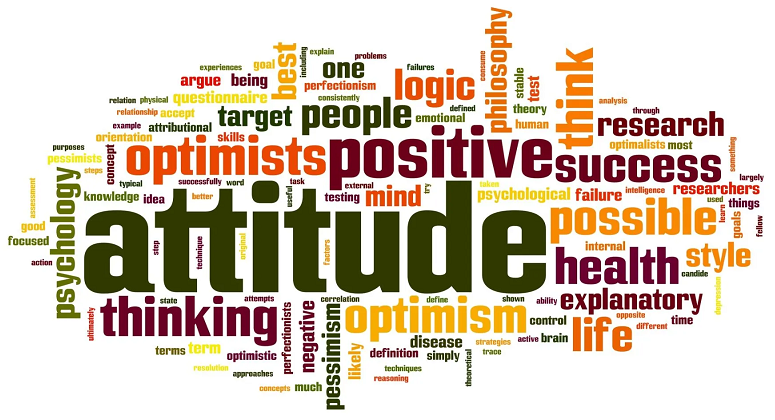In the field of psychology, attitudes play a crucial role in shaping our thoughts, feelings, and behaviours. They represent our evaluations and judgments toward people, objects, events, or ideas. Attitudes are complex and multifaceted, and psychologists have identified various types of attitude that influence human behaviour in different ways. Understanding these different types of attitude can provide valuable insights into how individuals perceive and interact with the world around them. In this article, we will explore the different types of attitude in psychology, their characteristics, and their impact on human behaviour.
Power of Positive Thinking: Different Types Of Attitude In Psychology
Here we listed the different types of Attitude in human psychology. Let’s have a look at them.
1. Positive Attitudes:
Positive attitudes refer to favourable evaluations or beliefs that individuals hold toward a person, object, or idea. These attitudes are characterized by optimism, enthusiasm, and a tendency to see the good in others or situations. Positive attitudes can enhance motivation, foster resilience, and promote healthy relationships. They contribute to a positive outlook on life and are often associated with increased well-being and success.
2. Negative Attitudes:
On the other hand, negative attitudes involve unfavourable evaluations or beliefs toward a person, object, or idea. Negative attitudes are characterized by pessimism, cynicism, and a tendency to focus on faults or weaknesses. These attitudes can hinder personal growth, strain relationships, and contribute to feelings of dissatisfaction or unhappiness. Negative attitudes can have a detrimental impact on mental health and overall quality of life.
3. Ambivalent Attitudes:
Ambivalent attitudes reflect mixed or conflicting evaluations toward a person, object, or idea. Individuals with ambivalent attitudes experience both positive and negative feelings simultaneously, making it challenging to form a clear and consistent opinion. Ambivalence can lead to uncertainty, indecision, and internal conflict. This type of attitude is often observed in situations where individuals perceive both positive and negative aspects or when they have conflicting desires or goals.
4. Explicit Attitudes:
Explicit attitudes are consciously held attitudes that individuals are aware of and can easily articulate. These attitudes are the ones people openly express or endorse when asked directly. For example, a person may explicitly state that they have a positive attitude toward exercise and believe it is essential for their health. Explicit attitudes are often shaped by personal experiences, social norms, and cultural influences.
5. Implicit Attitudes:
In contrast, implicit attitudes are unconscious or automatic evaluations that individuals may not be aware of or able to express easily. These attitudes are developed through repeated experiences and associations in the subconscious mind. Implicit attitudes can influence behaviour without conscious intention or awareness. For example, a person may implicitly hold negative attitudes toward a particular social group despite explicitly expressing acceptance or tolerance.
6. Functional Attitudes:
Functional attitudes refer to attitudes that serve a specific purpose or fulfil a particular psychological need. These attitudes help individuals achieve their goals, adapt to their environment, or manage their emotions. For instance, a person may develop a positive attitude toward public speaking as it helps them advance in their career or overcome their fear of public speaking.
See More: Types of Dogs
7. Structural Attitudes:
Structural attitudes represent the underlying organization or framework of an individual’s attitudes. These attitudes can be hierarchical, with some attitudes serving as central or core beliefs that guide other attitudes. Structural attitudes provide stability and coherence to an individual’s overall attitude system. Changes in structural attitudes often require significant shifts in core beliefs or values.
8. Evaluative Attitudes:
Evaluative attitudes involve judgments or assessments of the positive or negative value of a person, object, or idea. These attitudes are influenced by personal preferences, cultural norms, and individual experiences. Evaluative attitudes guide individuals’ decisions, behaviours, and interactions with others. They contribute to the formation of opinions and influence the way individuals perceive and evaluate their surroundings.
9. Behavioural Attitudes:
Behavioural attitudes focus on the relationship between attitudes and behaviour. These attitudes explore how attitudes shape and influence an individual’s actions and choices. Behavioural attitudes examine the consistency between what individuals say (explicit attitudes) and what they do (behavioural expressions). Understanding the behavioural aspects of attitudes is essential for predicting and explaining human behaviour.
10. Cognitive Attitudes:
Cognitive attitudes pertain to the thoughts, beliefs, and knowledge associated with a particular attitude. These attitudes involve the cognitive processes individuals engage in when forming or expressing their attitudes. Cognitive attitudes include beliefs, expectations, and information-processing strategies. They influence how individuals perceive, interpret, and make sense of the world around them.
11. Affective Attitudes:
Affective attitudes involve the emotional or affective component of attitudes. These attitudes encompass the feelings, emotions, and moods associated with a particular attitude. Affective attitudes can range from positive emotions, such as happiness or love, to negative emotions, such as anger or fear. The affective component of attitudes plays a significant role in shaping individuals’ emotional responses and subjective experiences.
12. Explicit-Behavioral Consistency:
Explicit-behavioural consistency refers to the alignment between explicit attitudes and overt behaviours. When individuals’ explicit attitudes align with their behaviours, there is consistency and congruence. For example, if someone expresses a positive attitude toward recycling and consistently engages in recycling behaviours, there is explicit-behavioural consistency. Inconsistencies between explicit attitudes and behaviours can lead to cognitive dissonance.
See More: Types of Agriculture
13. Implicit-Behavioral Consistency:
Implicit-behavioural consistency examines the alignment between implicit attitudes and behaviours. This aspect focuses on the relationship between automatic or unconscious evaluations and observable actions. Individuals may exhibit implicit-behavioural consistency when their automatic responses and behaviours align with their implicit attitudes. Understanding implicit-behavioural consistency provides insights into the subtle influences that shape behaviour.
14. Attitude Formation:
Attitude formation refers to the process by which attitudes develop and change over time. Attitudes can be shaped by various factors, including personal experiences, socialization, cultural influences, and media exposure. The formation of attitudes involves cognitive processes, emotional responses, and social interactions. Understanding the processes involved in attitude formation can help us comprehend why individuals hold certain attitudes and how they can be influenced or changed.
15. Attitude Change:
Attitude change refers to the modification of existing attitudes or the adoption of new attitudes. Attitudes can change through persuasive communication, exposure to new information, personal experiences, and social influences. Attitude change can be gradual or sudden, depending on the nature of the attitude and the factors that contribute to its alteration. Recognizing the factors that facilitate attitude change is crucial for effective communication and behaviour modification.
16. Attitude Behavior Relationship:
The attitude-behaviour relationship explores the link between attitudes and behaviour. While attitudes provide a general framework for predicting behaviour, there is not always a direct correspondence between the two. The relationship between attitudes and behaviour is influenced by various factors, including situational constraints, personal values, social norms, and individual characteristics. Understanding the complexities of the attitude-behaviour relationship helps us interpret and predict human actions more accurately.
17. Cognitive Dissonance:
Cognitive dissonance theory suggests that individuals experience psychological discomfort or dissonance when their attitudes, beliefs, or behaviours are inconsistent or contradictory. This discomfort motivates individuals to reduce the dissonance by changing their attitudes, beliefs, or behaviours. Cognitive dissonance can arise when there is a conflict between what individuals believe and how they behave. Resolving cognitive dissonance often involves rationalization or attitude change to restore internal consistency.
Attitudes play a significant role in psychology, influencing how individuals perceive, evaluate, and interact with the world. Understanding the different types of attitude provides insights into the complexities of human behaviour and decision-making processes. Positive attitudes contribute to personal well-being and success, while negative attitudes can hinder growth and relationships. Attitudes can be consciously expressed (explicit attitudes) or unconsciously held (implicit attitudes), and they can influence behaviour in various ways. By exploring attitude formation, attitude change, and the attitude-behaviour relationship, we gain a deeper understanding of the factors that shape human attitudes and actions. Recognizing the dynamic nature of attitudes and their impact on individuals and society helps foster empathy, open-mindedness, and effective communication.
Frequently Asked Questions:
1. What are the different types of attitude in psychology?
In psychology, different types of attitude include positive attitudes, negative attitudes, ambivalent attitudes, explicit attitudes, implicit attitudes, functional attitudes, structural attitudes, evaluative attitudes, behavioural attitudes, cognitive attitudes, and affective attitudes.
2. How do attitudes influence behaviour?
Attitudes influence behaviour by shaping individuals’ thoughts, emotions, and actions toward a person, object, or idea. Positive attitudes can motivate positive behaviours, while negative attitudes can lead to negative behaviours. Attitudes serve as filters through which individuals perceive and respond to the world, influencing their choices, decisions, and interactions.
3. Can attitudes be changed?
Yes, attitudes can be changed through various processes. Attitude change can occur through persuasive communication, exposure to new information or experiences, cognitive dissonance, social influences, and personal reflection. However, changing attitudes is a complex process that requires careful consideration of individual factors, such as beliefs, values, and motivations.
4. What is cognitive dissonance?
Cognitive dissonance refers to the psychological discomfort experienced when individuals hold contradictory beliefs, attitudes, or behaviours. This discomfort motivates individuals to reduce the dissonance by either changing their attitudes or beliefs, seeking information that supports their existing attitudes, or rationalizing their inconsistent behaviours.
5. Are attitudes permanent?
Attitudes can be relatively stable but are not necessarily permanent. Attitudes can change over time due to personal experiences, exposure to new information, or shifts in social and cultural contexts. While some attitudes may be resistant to change, others can be modified or replaced through various influencing factors.
6. Do attitudes differ among cultures?
Yes, attitudes can vary among different cultures and societies. Cultural norms, values, and beliefs shape individuals’ attitudes and influence their perceptions and behaviours. Attitudes are social constructs that are influenced by cultural factors, including language, socialization practices, and societal expectations.







